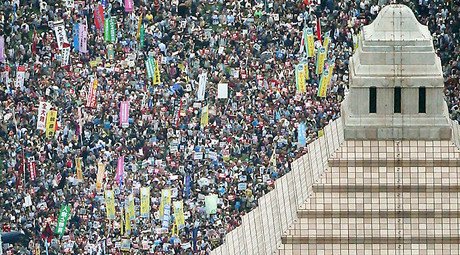Japan to get first aircraft carriers since World War II as part of record $242bn defense plan
For the first time since World War II, Japan is seeking aircraft carriers to counter what it says is a growing threat from China. Tokyo also wants to purchase over 100 F-35s as part of a staggering $242-billion defense plan.
Japan will spend the hefty sum on top-notch equipment between now and 2024, according to a record five-year military budget approved on Tuesday. The spending plan includes the acquisition of two aircraft carriers capable of launching fighter jets.
The ships will not be built from scratch, and will instead be converted from a pair of flat-top Izumo-class helicopter carriers that are currently operated by the Japanese Navy. The 27,000-ton vessels, named after old Japan’s Izumo province, is the largest in the Navy’s inventory.
Also on rt.com ‘You’ve gained public trust’: Japan’s Abe boasts army’s reputation as he drives to beef up defenseIt has neither a ski-jump nor a catapult, but has the potential to accommodate fixed-wing aircraft that are capable of short take-off and vertical landing (STOVL) operations. The F-35B is apparently the only candidate to fulfil this role, and the hefty Japanese defense budget also includes buying 42 such fighters over the coming decade.
The new ships and fighter jets are set to “increase operational flexibility” for the military in terms of protecting remote Japanese islands in southern waters, a defense official told AFP. “We have a very, very small [military] footprint” in the area between Okinawa and Taiwan, he said.
However, it would be wrong to believe that the upgrades will turn the Izumo-class vessels into “full-fledged aircraft carriers,” the official said. “We are not creating carrier air wings or carrier air squadrons” like the US Navy, he explained, adding that the incoming F-35s would be stationed at existing ground facilities rather than on the ships.
If retrofitted, the Izumo-class ships will become Japan’s first aircraft carriers since the end of World War II. During the war, the Imperial Japanese Navy had 10 carriers, including the ones that took part in the attack on Pearl Harbor.
After World War II, Japan’s constitution outlawed war and prohibited building up a military that would have offensive capabilities.
However, Prime Minister Shinzo Abe has put particular emphasis on abandoning the pacifist clause, citing emerging “threats” from China and North Korea. His government has ramped up efforts to procure offensive weapons, including Tomahawk cruise missiles and F-35s, as well as training troops to conduct expeditionary operations overseas.
Earlier this year, for instance, Japan’s Self-Defense Forces activated its first Marine brigade since World War II. The new force, which contains 2,100 troops in total, will primarily defend the country’s remote southwest islands.
Abe’s plans to amend the pacifist constitution have ignited numerous protests from the Japanese public. Anti-war rallies attracted thousands of people in Tokyo and other cities, where protesters accused the government of warmongering and ramping up tensions in the region. The potential overseas deployment of Japan’s troops was also at the core of the rallies.
Think your friends would be interested? Share this story!















